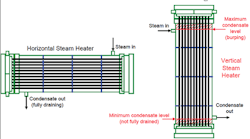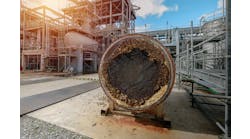[pullquote]
Plants often use steam to handle process heating duties because it’s relatively cheap and has high heat-transfer coefficients. Such duties include both sensible heating and vaporization (reboilers, vaporizers and evaporators).
While most shell-and-tube exchangers are installed horizontally, smaller units or ones in constrained areas may have a vertical orientation. Figure 1 illustrates the steam configuration of both horizontal and vertical shell-and-tube exchangers.
Both exchangers use a tube support rather than a baffle configuration on the tube side. Because the duty comes from condensing steam, the steam side of the exchanger is isothermal. With a constant temperature on the steam side, baffles on that side offer no heat transfer benefit. Configurations with baffles may make sense if subcooling the condensate is necessary. Here, we’ll restrict ourselves to the simpler configuration that uses tube supports and lacks baffles on the steam side.
The most common methods of duty control in a steam heater are to vary the pressure of the steam or the condensate level in the exchanger (see: “Don’t Let Heater Control Get You Steamed”). Varying the pressure changes the steam temperature to control the duty. Varying the condensate level changes the surface area split between condensing (with a high heat-transfer coefficient) and condensate subcooling (with a low heat-transfer coefficient) to control the duty.
Figure 1. Horizontal exchangers fully drain condensate but vertical units do not.
Horizontal exchangers have a full range of operation for both control systems. As shown in Figure 1, steam enters the top of the shell and condensate leaves the bottom. In a properly configured unit with correctly sized tube supports (or baffles) and nozzles, the exchanger has full flexibility to drain condensate from the top edge of the tube bundle to the bottom edge. With pressure control, the entire surface is available for condensing at all times. With level control, the condensate level can move from below the bottom tube to above the top tube without a problem.
Vertical exchangers lack this capability. Nozzles on the shell have a minimum offset from the head flanges due to fabrication welding requirements or clearances necessary for bolting and piping attachment. This nozzle offset can create limits or problems for both minimum and maximum exchanger duties.
At the bottom of the exchanger, some tube surface lies below the level of the nozzle. This section of the exchanger always holds some condensate. So, the effective maximum surface area of the exchanger never equals the actual physical surface area. This loss of area may be small — but will limit maximum exchanger heat duty.
At the top of the exchanger, some surface area lies above the level of the steam-inlet nozzle. For pressure control systems, this surface area is available for heat transfer and, so, doesn’t raise any special issues.
However, with condensate level control systems, it can pose a problem. If condensate level reaches the top of the nozzle, the condensate will prevent steam from entering. Steam trapped in the vapor space above the condensate may continue to condense, lowering the pressure above the condensate. Once the pressure above the condensate drops enough to offset the condensate’s static head, steam flows again. This flow is temporary, though, because the incoming steam causes the pressure above the condensate to rise. The exchanger burps, with steam entering intermittently. In some instances, such burping can lead to control problems and exchanger damage.
The burping problem occurs at low exchanger duties. It’s most common at low rates, startup and when other exchangers in a heat-integrated network have higher-than-normal performance. Trim duties in steam heaters may be very low in these situations, which may require temporary operation changes to decrease heat transfer effectiveness. One method to reduce burping is to lower steam system pressure — this will allow the condensate level to drop, thus avoiding the burping problem.
ANDREW SLOLEY is a Chemical Processing contributing editor. You can email him at
[email protected]



